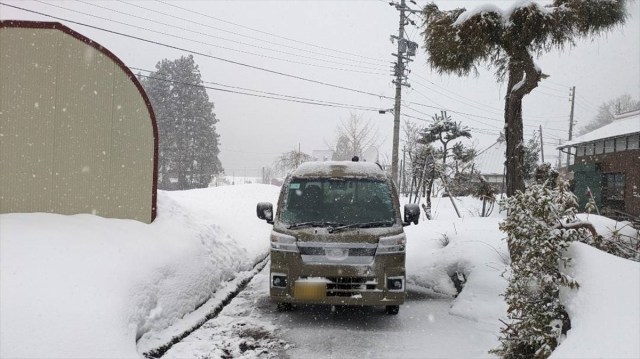
Locals teach us how to live comfortably in areas that experience heavy snowfall.
Japan is known for its four seasons, but not everyone in the country experiences a winter filled with snow. So when people from more temperament regions travel to colder climes during winter it can be an eye-opening experience.
Our reporter Haruka Takagi, who’s lived all her life in relatively warm areas of Japan along the Pacific Ocean, is one such person whose eyes were recently opened to the ways people in cold regions deal with heavy snowfall, after she visited a friend in Nagano Prefecture during a snowstorm.
▼ Haruka’s mode of transport while travelling around the area was a 4-wheel drive kei (“light”) vehicle.
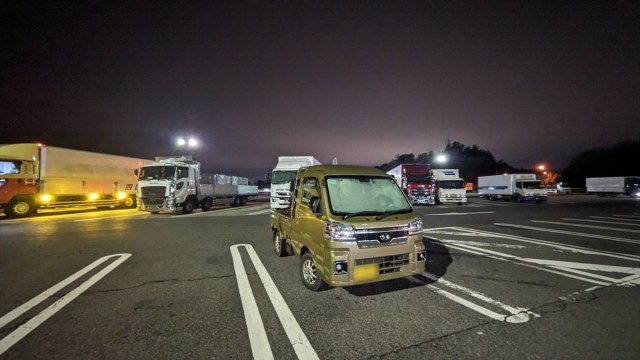
With heavy snow forecast for the afternoon, Haruka’s first introduction to local countermeasures came in the form of a hose system, which was spraying water out all over the parking lot of a convenience store.
▼ This was the first of six clever snow-coping mechanisms Haruka would discover during her stay.
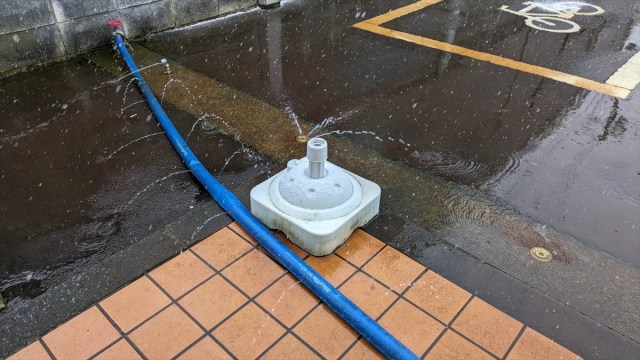
Not only was the water being sprayed from the hose, it was being pushed out from holes in the cement as well. Haruka soon learned that these sprinkler systems use groundwater to melt the snow, as water below the surface is naturally warmer than that above ground, making them common in snowy areas around Japan.
▼ These sprinklers are usually seen on public roads so it’s still quite unusual to see them in parking lots like this one.
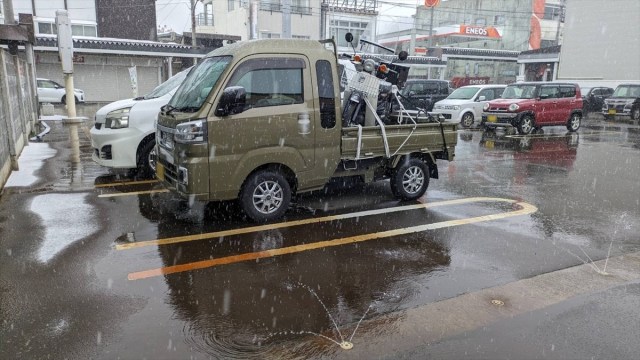
When snowy areas experience heavy snowfall, you can expect the whiteness to descend quickly, and that’s what happened when Haruka made her way through the windy roads to her friend’s house.
▼ The snowflakes were huge so it didn’t take long for the roads to be covered in snow.

Thankfully, Haruka had come prepared with studless tyres on her vehicle, a must when travelling to snowy regions. These tyres have deeper and more numerous grooves, giving them better drainage and grip, and they’re also cold-resistant, staying soft in low temperatures as opposed to regular tyres, which will harden in extremely cold environments.
Haruka thought the studless tyres worked amazingly well as they gripped the road and helped her feel safe even in the heavy snowfall, making her realise why they’re such a must-have for people living in cold areas.
After arriving at her destination safe and sound, Haruka was so exhausted from concentrating on the drive that she left her bike on the back of the truck and napped under her friend’s heated kotatsu table until evening.
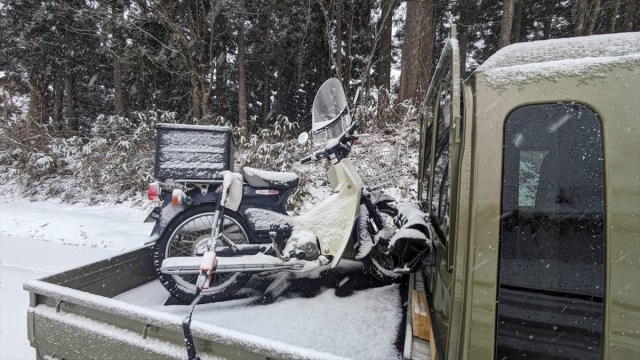
She’d planned to meet friends at a nearby onsen hot spring that evening, but when she left the house at around 7 p.m., she found herself up to her knees in snow.
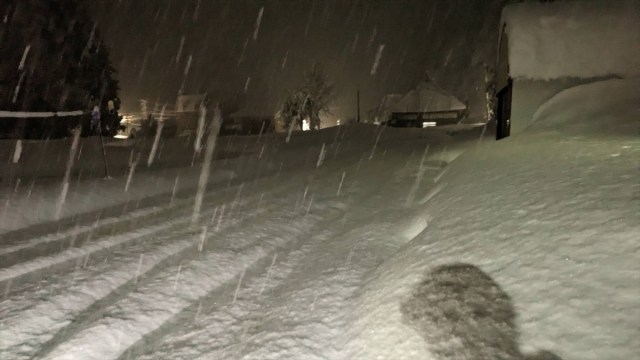
Thankfully, she was able to borrow her friend’s rain boots because she’d foolishly come with only a pair of sneakers, but the snow was still so heavy that the icy particles slipped through the gap between her boots and tucked-in trouser hems.
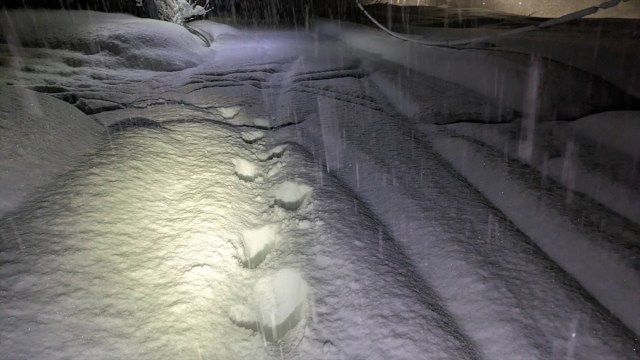
There was no way she’d be able to drive to the onsen in this weather, but now that she was out here she decided to retrieve her glasses, which she’d left in her car.
However, when she went to get them, she realised her car, which was parked behind the white one below, was completely surrounded by large mounds of snow, making it impossible for her to open the door.
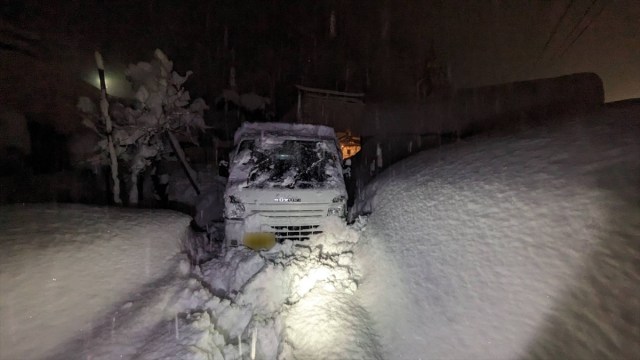
She borrowed a plastic shovel and dug around the door in an attempt to open it, but her friend had a better idea, coming to her aid with…
▼…a personal snow blower.
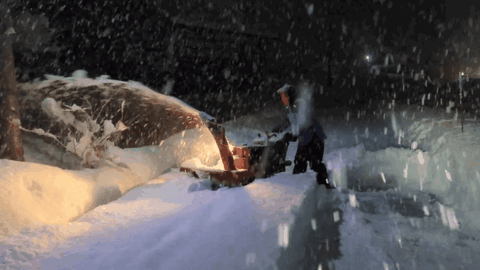
Haruka couldn’t believe her eyes, as she’d never known anyone to actually own their own snow blower, but her friend simply told her, “It’s not at all that uncommon around here”. According to her friend, even the elderly grandma who lives across the street from them operates a snow blower with ease, so it’s a daily necessity in winter that locals don’t bat an eye at.
▼ It worked like a charm, clearing enough snow from the path to allow better access.
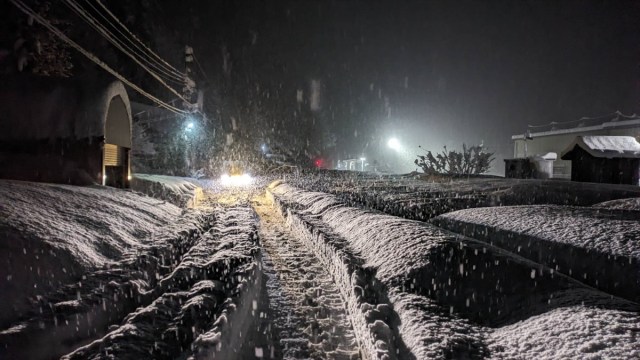
Just a few hours in the snow made Haruka realise how much she took her easy city life for granted. People in these snowy environments seemed to have such a strong get-up-and-go attitude by comparison, barely complaining about the inconvenience of having to operate machinery in freezing temperatures whereas she tends to grumble about having to leave the house when it’s only slightly cold.
As the night wore on and the snow began to cease, Haruka could hear the rumble and thud of snow falling from the roof, which shook the house with every drop. That’s when her eyes were opened to another way people deal with heavy snowfall — small ponds known as “tane”.
These ponds are traditionally set up on the north side of a home, with the theory being that snow on this side, which gets less sunlight, can become hard and compacted, making it difficult to remove. These ponds prevent snow from piling up on this side of the building, and many are often fed by natural spring water, helping to melt any snow that falls into them, thereby safeguarding the house and its residents.
▼ In summer, the ponds look beautiful with carp swimming in them to prevent stagnation, but in winter, they’re vital for melting ice.
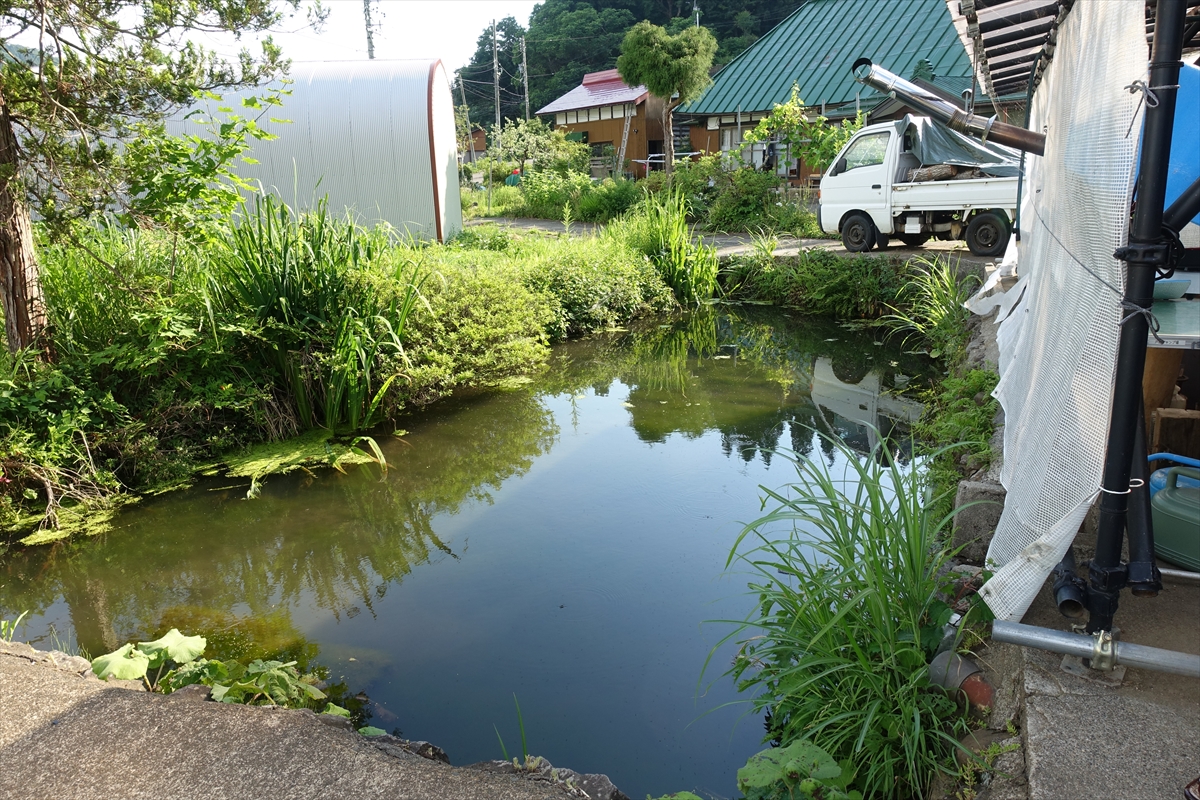
By morning, the snowfall had stopped and thanks to the fast and efficient snow removal service provided by the city, the roads were cleared to the point where the asphalt was visible. Thanks to this public service, Haruka was able to walk along roads at the top of the mountains in just her sneakers, although she did slip a few times.
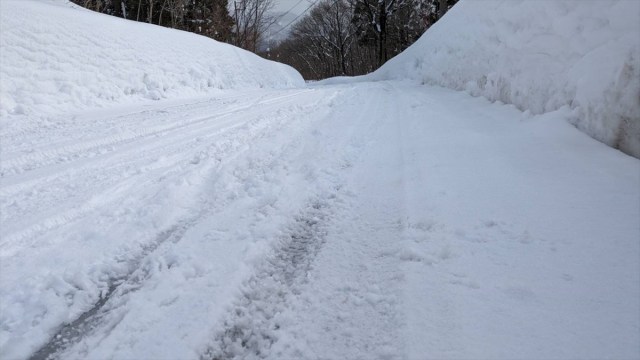
By the time she got to the city centre that night, the roads were clear, thanks to the use of snow melting agents, which made it as easy as driving in the rain.
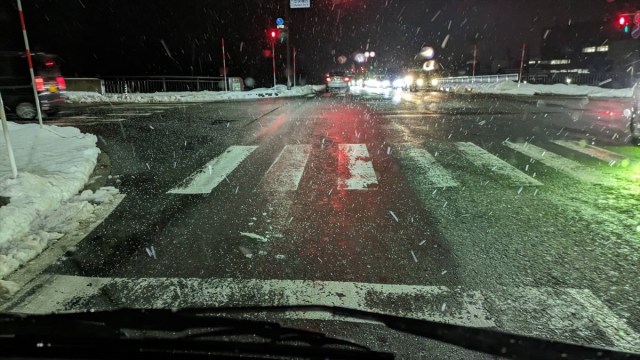
These salt-laden snow-melting agents can rust cars easily, so Haruka made a mental note to give her vehicle a good wash as soon as she returned home. When she drove away from the mountains and back to her city life, she reflected on the things she’d learnt during her trip, and realised she was returning with seven things she’d learned about dealing with the snow.
- The sprinkler systems are genius
- Studless tyres are a must
- Personal snow blowers will get you out of a jam in no time
- Traditional pond systems can be a literal lifesaver
- Snow removal by the city is fast
- Snow-melting agents help to clear roads but can rust vehicles
As for the seventh thing she’d learnt, it was that people who live in snowy regions are much stronger than she is, both physically and mentally. Coping with the many inconveniences that come with heavy snowfall requires resilience and a positive attitude, and now that she’s experienced this way of life firsthand, she plans to borrow that frame of mind to help her during her future travels. That way, she can better endure any possible hardships she might encounter…like that time she climbed Japan’s only highway staircase.
Photos ©SoraNews24
● Want to hear about SoraNews24’s latest articles as soon as they’re published? Follow us on Facebook and Twitter!
[ Read in Japanese ]

 We visit a train station in historical ninja town, see ninja trick art, and become ninjas ourselves
We visit a train station in historical ninja town, see ninja trick art, and become ninjas ourselves Vending machine noodle ice cream: A retro icon in Japan brings joy to a new generation
Vending machine noodle ice cream: A retro icon in Japan brings joy to a new generation Weird Japanese vending machine find gives us unique sweet potato sweets
Weird Japanese vending machine find gives us unique sweet potato sweets We visit Kaiyodo Kappa Museum: dedicated to a yokai that loves cucumbers and human souls
We visit Kaiyodo Kappa Museum: dedicated to a yokai that loves cucumbers and human souls We hunt for Dom Pérignon in these wine fukubukuro lucky bag boxes from Kaldi
We hunt for Dom Pérignon in these wine fukubukuro lucky bag boxes from Kaldi Japanese city loses residents’ personal data, which was on paper being transported on a windy day
Japanese city loses residents’ personal data, which was on paper being transported on a windy day Foreigner’s request for help in Tokyo makes us sad for the state of society
Foreigner’s request for help in Tokyo makes us sad for the state of society Should you add tartar sauce to Japanese curry rice? CoCo Ichi makes diners an unusual offer
Should you add tartar sauce to Japanese curry rice? CoCo Ichi makes diners an unusual offer Ghibli Park now selling “Grilled Frogs” from food cart in Valley of Witches
Ghibli Park now selling “Grilled Frogs” from food cart in Valley of Witches Seaside scenery, history, and so many desserts on Yokohama’s Akai Kutsu【Japan Loop Buses】
Seaside scenery, history, and so many desserts on Yokohama’s Akai Kutsu【Japan Loop Buses】 Historical figures get manga makeovers from artists of Spy x Family, My Hero Academia and more
Historical figures get manga makeovers from artists of Spy x Family, My Hero Academia and more Mt. Koya planning to instate visitor’s tax to cope with huge tourist numbers
Mt. Koya planning to instate visitor’s tax to cope with huge tourist numbers Beautiful Ghibli sealing wax kits let you create accessories and elegant letter decorations【Pics】
Beautiful Ghibli sealing wax kits let you create accessories and elegant letter decorations【Pics】 Suntory x Super Mario collaboration creates a clever way to transform into Mario【Videos】
Suntory x Super Mario collaboration creates a clever way to transform into Mario【Videos】 Shinjuku izakaya’s all-you-can-eat-and-drink plan is one of Tokyo’s best secret cheap eats
Shinjuku izakaya’s all-you-can-eat-and-drink plan is one of Tokyo’s best secret cheap eats McDonald’s new Happy Meals offer up cute and practical Sanrio lifestyle goods
McDonald’s new Happy Meals offer up cute and practical Sanrio lifestyle goods Japanese ramen restaurants under pressure from new yen banknotes
Japanese ramen restaurants under pressure from new yen banknotes French Fries Bread in Tokyo’s Shibuya becomes a hit on social media
French Fries Bread in Tokyo’s Shibuya becomes a hit on social media Studio Ghibli releases new action figures featuring Nausicaä of the Valley of the Wind characters
Studio Ghibli releases new action figures featuring Nausicaä of the Valley of the Wind characters New private rooms on Tokaido Shinkansen change the way we travel from Tokyo to Kyoto
New private rooms on Tokaido Shinkansen change the way we travel from Tokyo to Kyoto Red light district sushi restaurant in Tokyo shows us just how wrong we were about it
Red light district sushi restaurant in Tokyo shows us just how wrong we were about it Tokyo Tsukiji fish market site to be redeveloped with 50,000-seat stadium, hotel, shopping center
Tokyo Tsukiji fish market site to be redeveloped with 50,000-seat stadium, hotel, shopping center All-you-can-drink Starbucks and amazing views part of Tokyo’s new 170 meter-high sky lounge
All-you-can-drink Starbucks and amazing views part of Tokyo’s new 170 meter-high sky lounge Studio Ghibli releases Kiki’s Delivery Service chocolate cake pouches in Japan
Studio Ghibli releases Kiki’s Delivery Service chocolate cake pouches in Japan New definition of “Japanese whiskey” goes into effect to prevent fakes from fooling overseas buyers
New definition of “Japanese whiskey” goes into effect to prevent fakes from fooling overseas buyers Our Japanese reporter visits Costco in the U.S., finds super American and very Japanese things
Our Japanese reporter visits Costco in the U.S., finds super American and very Japanese things Studio Ghibli unveils Mother’s Day gift set that captures the love in My Neighbour Totoro
Studio Ghibli unveils Mother’s Day gift set that captures the love in My Neighbour Totoro More foreign tourists than ever before in history visited Japan last month
More foreign tourists than ever before in history visited Japan last month New Pokémon cakes let you eat your way through Pikachu and all the Eevee evolutions
New Pokémon cakes let you eat your way through Pikachu and all the Eevee evolutions Sales of Japan’s most convenient train ticket/shopping payment cards suspended indefinitely
Sales of Japan’s most convenient train ticket/shopping payment cards suspended indefinitely Sold-out Studio Ghibli desktop humidifiers are back so Totoro can help you through the dry season
Sold-out Studio Ghibli desktop humidifiers are back so Totoro can help you through the dry season Japanese government to make first change to romanization spelling rules since the 1950s
Japanese government to make first change to romanization spelling rules since the 1950s Ghibli founders Toshio Suzuki and Hayao Miyazaki contribute to Japanese whisky Totoro label design
Ghibli founders Toshio Suzuki and Hayao Miyazaki contribute to Japanese whisky Totoro label design Doraemon found buried at sea as scene from 1993 anime becomes real life【Photos】
Doraemon found buried at sea as scene from 1993 anime becomes real life【Photos】 Tokyo’s most famous Starbucks is closed
Tokyo’s most famous Starbucks is closed One Piece characters’ nationalities revealed, but fans have mixed opinions
One Piece characters’ nationalities revealed, but fans have mixed opinions We asked a Uniqlo employee what four things we should buy and their suggestions didn’t disappoint
We asked a Uniqlo employee what four things we should buy and their suggestions didn’t disappoint Princesses, fruits, and blacksmiths: Study reveals the 30 most unusual family names in Japan
Princesses, fruits, and blacksmiths: Study reveals the 30 most unusual family names in Japan Three sisters in Japan skip building a snowman, build awesome snow Totoro Catbus instead【Video】
Three sisters in Japan skip building a snowman, build awesome snow Totoro Catbus instead【Video】 Tokyo snowfall, the heaviest in four years, causes chaos in the capital 【Photos】
Tokyo snowfall, the heaviest in four years, causes chaos in the capital 【Photos】 Why are the roads so wide in Hokkaido? Simple question has a simple answer
Why are the roads so wide in Hokkaido? Simple question has a simple answer Town in Hiroshima now offering exciting… snow-shovelling tours?
Town in Hiroshima now offering exciting… snow-shovelling tours? Hokkaido’s Shikaribetsuko Kotan — the beautiful village of ice that melts away in the spring
Hokkaido’s Shikaribetsuko Kotan — the beautiful village of ice that melts away in the spring The most expensive ice cream in Japan? Metallic soft serve frays the nerves of staff who make it
The most expensive ice cream in Japan? Metallic soft serve frays the nerves of staff who make it Akita Prefecture is a stunning winter wonderland with the warmest of hearts【Video】
Akita Prefecture is a stunning winter wonderland with the warmest of hearts【Video】 Can slapping on some nose filters prevent the anguish of hay fever?
Can slapping on some nose filters prevent the anguish of hay fever? Drive your car on an airport runway at this secret spot in Japan
Drive your car on an airport runway at this secret spot in Japan Making a traditional Japanese dessert from “heaven grass”【Photos】
Making a traditional Japanese dessert from “heaven grass”【Photos】 Puyo Puyo Manju return after 21 years…and our Puyo Puyo fan reporter achieves a childhood dream
Puyo Puyo Manju return after 21 years…and our Puyo Puyo fan reporter achieves a childhood dream To hike or hibernate for the winter? The woes of a Hokkaido University student
To hike or hibernate for the winter? The woes of a Hokkaido University student Mt Fuji looks unusual, sparks fears of possible eruption
Mt Fuji looks unusual, sparks fears of possible eruption When Kyoto snow falls, this mountain shrine becomes one of the most beautiful places in the city
When Kyoto snow falls, this mountain shrine becomes one of the most beautiful places in the city Japanese survey ranks Hokkaido as the most desirable prefecture to settle down in
Japanese survey ranks Hokkaido as the most desirable prefecture to settle down in Dog days of winter look like much more fun than the heat of summer
Dog days of winter look like much more fun than the heat of summer Visit a pepper-packed tribute to spiciness tucked away in an Osaka food court
Visit a pepper-packed tribute to spiciness tucked away in an Osaka food court
Leave a Reply